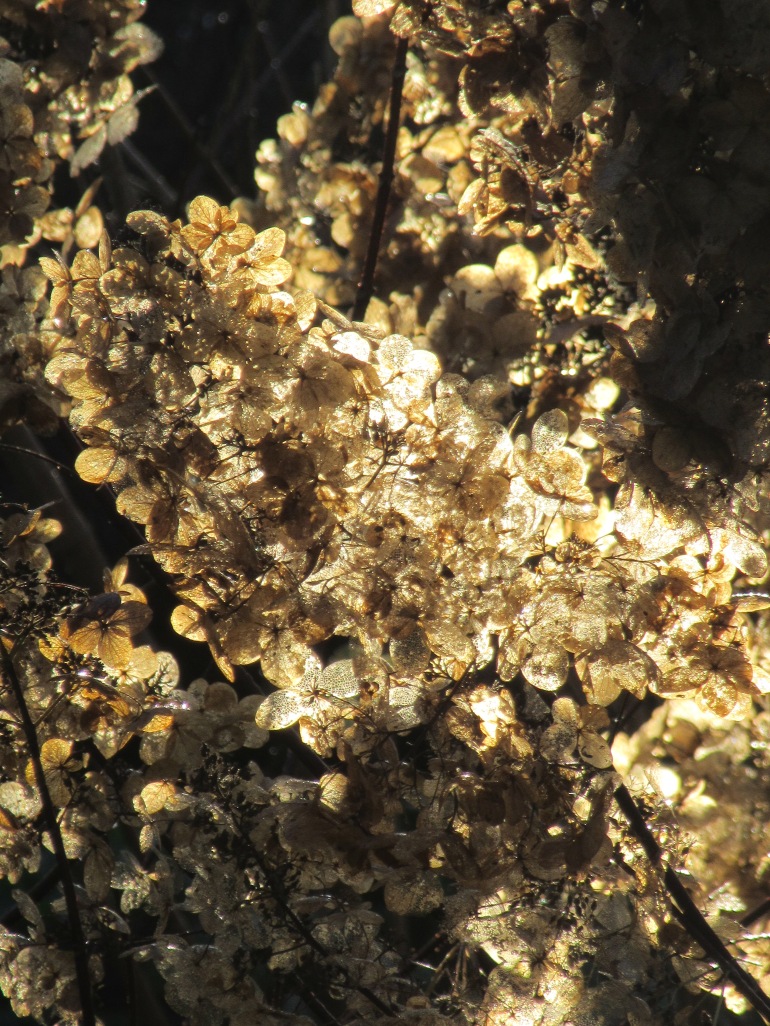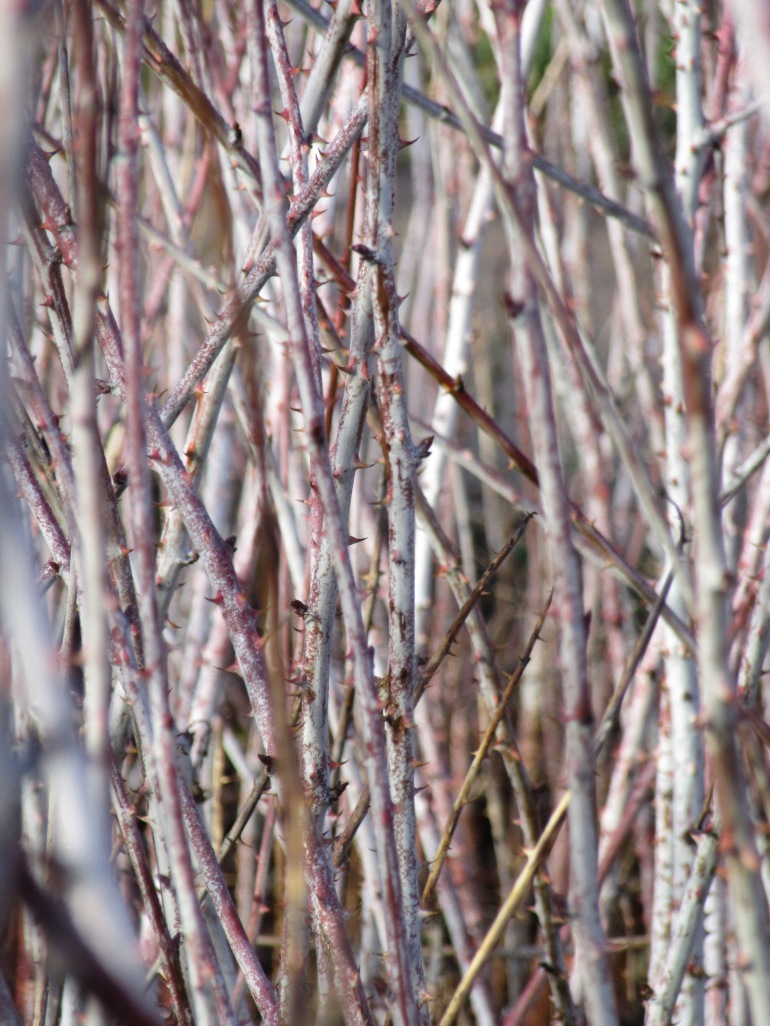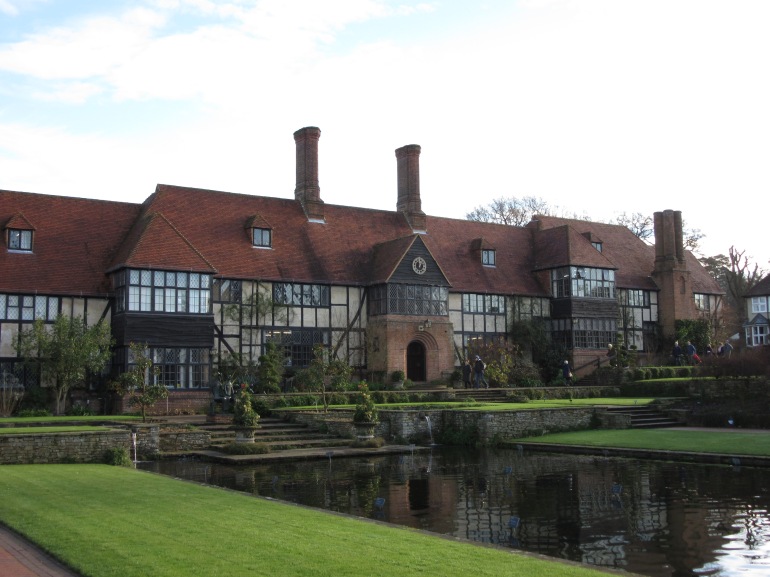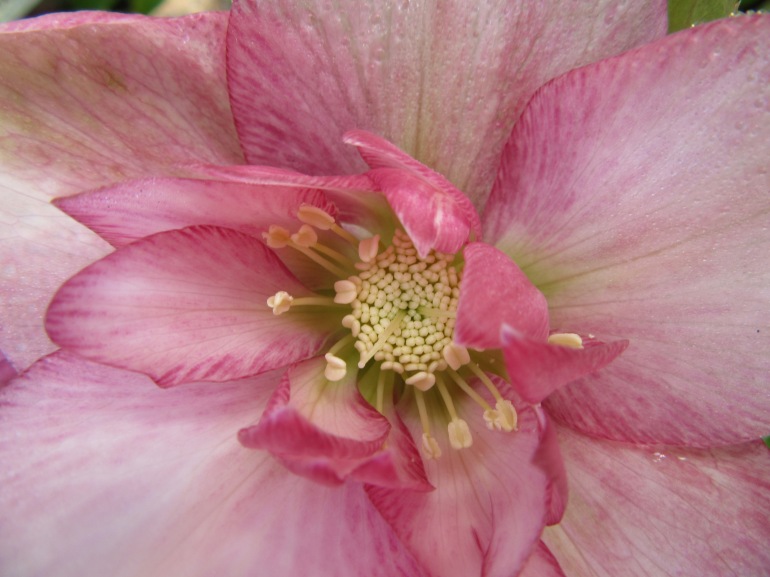 Acer griseum, lauded for its peeling bark, caught here in the chill morning sunlight on the slopes of Battleston Hill at the RHS gardens at Wisley. The gardens feature the remnants of many fine plants, dying beautifully, hydrangeas foremost in this class, as well as the heralds of a new season, with the earliest hellebores and camellias adding vibrant colour to the landscape.
Acer griseum, lauded for its peeling bark, caught here in the chill morning sunlight on the slopes of Battleston Hill at the RHS gardens at Wisley. The gardens feature the remnants of many fine plants, dying beautifully, hydrangeas foremost in this class, as well as the heralds of a new season, with the earliest hellebores and camellias adding vibrant colour to the landscape.
 A fine stand of Hydrangea paniculata Vanille Fraise – photographed in full colour earlier in the year and still forming a significant presence in the winter garden.
A fine stand of Hydrangea paniculata Vanille Fraise – photographed in full colour earlier in the year and still forming a significant presence in the winter garden.


 Some species maintain their bulk, substantial elements in the gardens still – others give up almost everything, a fine tracery of veins all that remains –
Some species maintain their bulk, substantial elements in the gardens still – others give up almost everything, a fine tracery of veins all that remains –


 Work in the big herbaceous borders, you can see the bulk of the hydrangeas on the slopes in the distance
Work in the big herbaceous borders, you can see the bulk of the hydrangeas on the slopes in the distance

 Bare stems and bone white, but by no means bleak – Rubus biflorus has a chalky bloom along the architectural stems, straight before arching over. Other ornamental blackberries punctuate otherwise incredibly colourful stems of dogwood – like Cornus sanguinea Midwinter Fire – and willow – Salix Yelverton – to great effect.
Bare stems and bone white, but by no means bleak – Rubus biflorus has a chalky bloom along the architectural stems, straight before arching over. Other ornamental blackberries punctuate otherwise incredibly colourful stems of dogwood – like Cornus sanguinea Midwinter Fire – and willow – Salix Yelverton – to great effect.


 A perfect seat for one… at least the dogwoods and willows lack these punishing thorns.
A perfect seat for one… at least the dogwoods and willows lack these punishing thorns.

 Retracing my steps this morning, as I have skipped along rather merrily to the lake and the Winter Garden and gotten ahead of myself, back to Battleston Hill. A wide grass slope leads up from the herbaceous borders and curving grass or bark paths lead off into the surrounding woodland. Near the top of the main slope (to where the Henry Moore Arch usually stands – it is out on loan to Compton Verney at the moment), one tree stands out, laden with berries – Sorbus carmesina – previously known as Sorbus hupehensis – I didn’t know it had changed. I’ve loved a particular form called Pink Pagoda so will have to investigate further.
Retracing my steps this morning, as I have skipped along rather merrily to the lake and the Winter Garden and gotten ahead of myself, back to Battleston Hill. A wide grass slope leads up from the herbaceous borders and curving grass or bark paths lead off into the surrounding woodland. Near the top of the main slope (to where the Henry Moore Arch usually stands – it is out on loan to Compton Verney at the moment), one tree stands out, laden with berries – Sorbus carmesina – previously known as Sorbus hupehensis – I didn’t know it had changed. I’ve loved a particular form called Pink Pagoda so will have to investigate further.
http://www.kevockgarden.co.uk/plantlist/pl14sep_sorbus_carmesina_b_l12545.htm
“…used to be known as the pink-berried form of Sorbus hupehensis, also known as var. obtusa or as named varieties ‘Rosea’ or ‘Pink Pagoda’, and then it was named S. pseudohupehensis. Now this collection has been named Sorbus carmesina. It has bluish green pinnate leaves, and large clusters of rich pink fruit, which are always wonderful, and in the best years are better than that, remaining while the leaves turn yellow, orange, red.”

 Berries elsewhere – tiny crab apples actually – on Malus transitoria, wide-spreading branches punctuated with a mist of golden-yellow –
Berries elsewhere – tiny crab apples actually – on Malus transitoria, wide-spreading branches punctuated with a mist of golden-yellow –

 The ‘Main Events’ in the woodlands are undoubtedly the Camellias – the earliest japonicas and the timely sasanquas – and some particularly prolific early stars amongst this select group. Show Girl in particular was in full spate with gorgeous large rich pink flowers.
The ‘Main Events’ in the woodlands are undoubtedly the Camellias – the earliest japonicas and the timely sasanquas – and some particularly prolific early stars amongst this select group. Show Girl in particular was in full spate with gorgeous large rich pink flowers.


 Camellia grijsii (pronounced greece-ee-eye) has smaller white (though also pink and red flowers within the species) fragrant flowers with heart-shaped petals and small, leathery, toothed leaves.
Camellia grijsii (pronounced greece-ee-eye) has smaller white (though also pink and red flowers within the species) fragrant flowers with heart-shaped petals and small, leathery, toothed leaves.

 Camellia japonica Gloire de Nantes, a smallish specimen but packed with these rich well-formed flowers
Camellia japonica Gloire de Nantes, a smallish specimen but packed with these rich well-formed flowers

 and finally in this selection, Camellia hiemalis Sparkling Burgundy
and finally in this selection, Camellia hiemalis Sparkling Burgundy

 Chomonathus praecox, Wintersweet, was also, just, breaking bud and coming into flowers, with an outer set of translucent petals and an inner flush of red/burgundy.
Chomonathus praecox, Wintersweet, was also, just, breaking bud and coming into flowers, with an outer set of translucent petals and an inner flush of red/burgundy.
Ursula Buchan writes very engagingly in this Telegraph article if you want to find out more –
http://www.telegraph.co.uk/gardening/howtogrow/3297316/How-to-grow-wintersweet.html
 This little fellow was quite happy for me to take a few photos while breakfast was taken…
This little fellow was quite happy for me to take a few photos while breakfast was taken…
 Colourful, but in leaf this time, Rhododendron Elsie Lee, caught my eye…
Colourful, but in leaf this time, Rhododendron Elsie Lee, caught my eye…

 Sputnik seedheads of Fatsia japonica
Sputnik seedheads of Fatsia japonica
 I neglected to note the name of this spectacular cascade of white, at the base of the Rockery.. dear reader, it is a…? Iris unguicularis meanwhile I do know, also on the slopes of the substantial Rockery
I neglected to note the name of this spectacular cascade of white, at the base of the Rockery.. dear reader, it is a…? Iris unguicularis meanwhile I do know, also on the slopes of the substantial Rockery

 The Canal and House – with the King and Queen, at the top of the shallow flight of steps leading from the water. A bronze Henry Moore, the Artist’s Copy, which has been on display for much of the past year. I was drawn to the peaceful pose of the hands…
The Canal and House – with the King and Queen, at the top of the shallow flight of steps leading from the water. A bronze Henry Moore, the Artist’s Copy, which has been on display for much of the past year. I was drawn to the peaceful pose of the hands…


 And this leads me finally into the Plant Centre – it really was too early for hellebores out in the landscape – but as ever, there was much to tempt. This prize beauty, Harvington Rebekah, is a recent introduction and is truly stunning, large flowers, superb colour, strong plants…
And this leads me finally into the Plant Centre – it really was too early for hellebores out in the landscape – but as ever, there was much to tempt. This prize beauty, Harvington Rebekah, is a recent introduction and is truly stunning, large flowers, superb colour, strong plants…

 Walberton’s Rosemary was also looking fine…
Walberton’s Rosemary was also looking fine…




 Whites there were aplenty too – cultivars and crosses with Helleborus niger mostly. All utterly charming.
Whites there were aplenty too – cultivars and crosses with Helleborus niger mostly. All utterly charming.
 And this brings my visit to a close. Plenty to see on my next trip – I’ll be paying close attention to the Fruit Display Garden where all manner of espaliers, cordons, double ‘U’s, fans and step-overs are on display. I’ve a workshop on Fruit Tree Pruning at the end of January and am sure to find some great visuals and a big dose of inspiration here. The IGPOTY winners are on display, as a final mention, by the Lake – and there are some really outstanding pictures as you might expect.
And this brings my visit to a close. Plenty to see on my next trip – I’ll be paying close attention to the Fruit Display Garden where all manner of espaliers, cordons, double ‘U’s, fans and step-overs are on display. I’ve a workshop on Fruit Tree Pruning at the end of January and am sure to find some great visuals and a big dose of inspiration here. The IGPOTY winners are on display, as a final mention, by the Lake – and there are some really outstanding pictures as you might expect.


Your photo of the peeling bark on a maple tree is stunning!
Thank you.
John in California
>
Reblogged this on The Teddington Gardener.